Italian painting of the 18th century is represented by a large group of landscapes that illustrate the main developments in this important genre of the time. There are ten works by Jan Frans van Bloemen, known as Orizzonte, in the Palazzo Koch collection, the largest selection of his works after that of the Galleria Doria Pamphilj. Orizzonte drew inspiration from the great 17th-century landscape artists such as Poussin, Lorrain and Dughet, although his style is less grandiose. The artist sought to depict tales from mythology or episodes from the Bible in a more natural and harmonious setting.
The work of Van Bloemen is echoed in the paintings of Andrea Locatelli and Hendrik Frans van Lint. These artists are regarded, together with Van Bloemen, as the main representatives of the genre that depicted a luminous Arcadian Roman countryside according to the tastes and demands of contemporary collectors. The passion for vedute of ancient and modern Rome spread to numerous foreign artists working in the city, including the well-known Jean-Baptiste Lallemand. The painting by Pieter van Bloemen is also illustrative of the continuing enthusiasm in 18th-century Italy for the genre themes depicted by the Bamboccianti a century earlier.
Outside Rome, 18th-century Italian vedutism is well-represented by the works of Luca Carlevarijs and Alessandro Magnasco. The latter, working in the middle of the Age of Enlightenment, sought to revive the genre of the pre-Romantic landscape introduced by Salvator Rosa and thus contributed to the later development of the 18th-century veduta.
The evolution of historical painting is instead dominated by the academic and classicist influence of Carlo Maratti, reflected in the painting by Giuseppe Bartolomeo Chiari and in the two works of Sebastiano Conca. Conca, in particular, re-interpreted the master’s language, enriching it with unprecedented luminosity and brilliance. The fine painting by Paolo de Matteis, from Puglia, also belongs to the widespread Arcadian movement of the first half of the century.
The quick, bright style of Giuseppe Maria Crespi, whose work is exemplified by a painting executed in his workshop, was the bridge between art in Rome in the early 18th-century and art in Venice in the following decades, as well as inspiring some of the methods introduced by Giovanni Battista Piazzetta and Pietro Longhi, both pupils of the Bolognese painter.
The works in the collection of the Bank of Italy thus provide an exhaustive illustration of the various trends and genres that coexisted during the 18th century, ranging from classical landscape to vedutism.
Il Settecento
The 18th Century
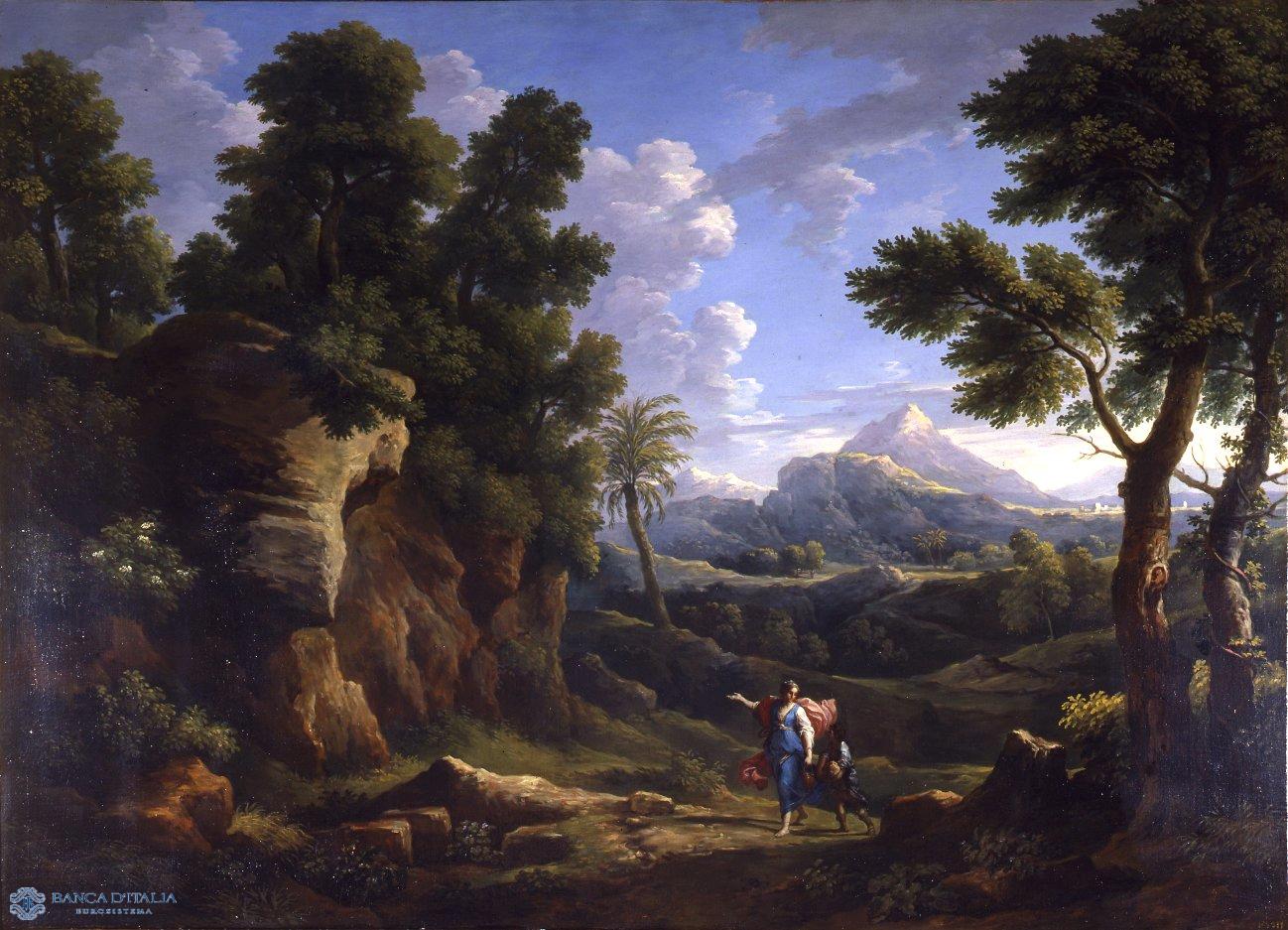
Works of art
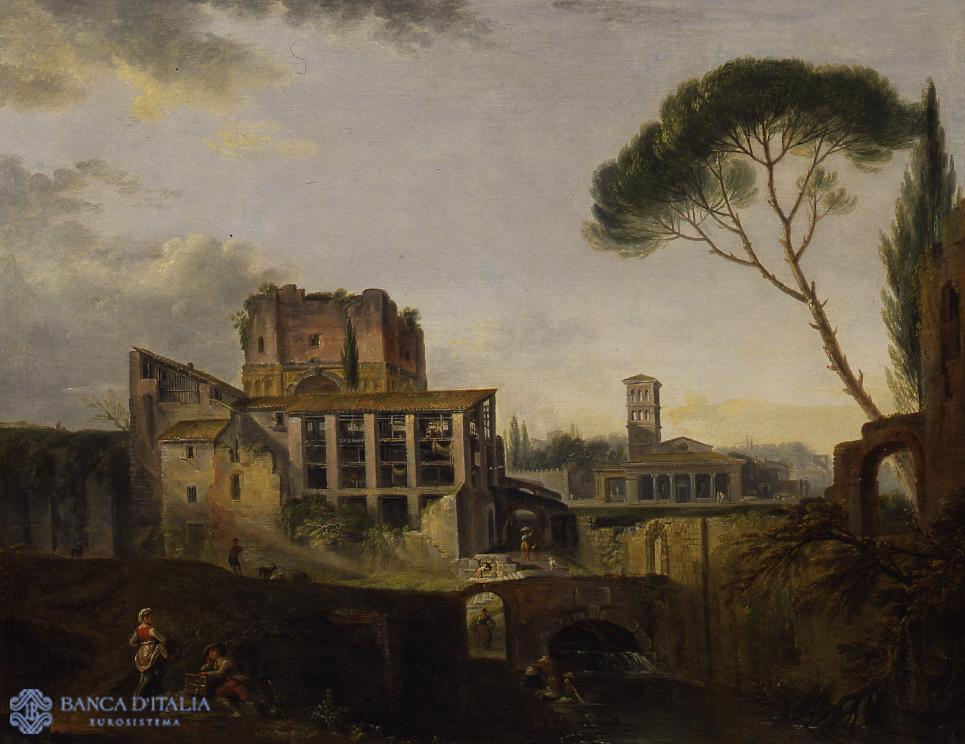
View with the Arch of Janus and San Giorgio al Velabro
A series of easily identified Roman buildings and ruins are depicted under a bright sky with just a few darkening clouds. In the background are the Church of San Giorgio al Velabro, with its tall bell tower, and the adjacent Arch of the Silversmiths, while on the left, partially hidden behind a factory or drying room, rises the bulk of the Arch of Janus.
Painting
18th century AD
Landscape

View of the Castle of Lunghezza
In the centre of van Bloemen’s vast composition rise the many towers of the Castle of Lunghezza, at the gates of Rome, which the Barberini family acquired and renovated in the course of the seventeenth century. In the foreground, three figures can be seen at the side of a path set between a thicket and a winding stream.
Painting
18th century AD
Landscape

View with Two Towns and a Small Circular Temple
In a typically Mediterranean landscape of ilex, pine and shrubs, a group of people wind their way along a dirt track. A woman sits in the foreground; behind her, a flock of goats and sheep approaches. In the background are several men wearing typical costumes of the Latium region.
Painting
18th century AD
Landscape

The Triumph of Galatea
This fine depiction of The Triumph of Galatea, signed and dated ‘Paulo de Matteis 1700’, comes from the Gualino Collection. It achieves a very successful balance between seventeenth-century Baroque and the Classicism of the art academies of the eighteenth century.
Painting
18th century AD
Biblical - Historical - Mythologic

Rebecca at the Well
The episode depicted is from the Book of Genesis and describes the meeting between Rebecca and the slave Eliezer, whom Abraham sent to find a wife for his son Isaac. The beautiful young Rebecca is portrayed with porcelain skin and wearing classical robes, sitting next to the well as she receives a gift of precious jewellery from Eliezer.
Painting
18th century AD
Biblical - Historical - Mythologic
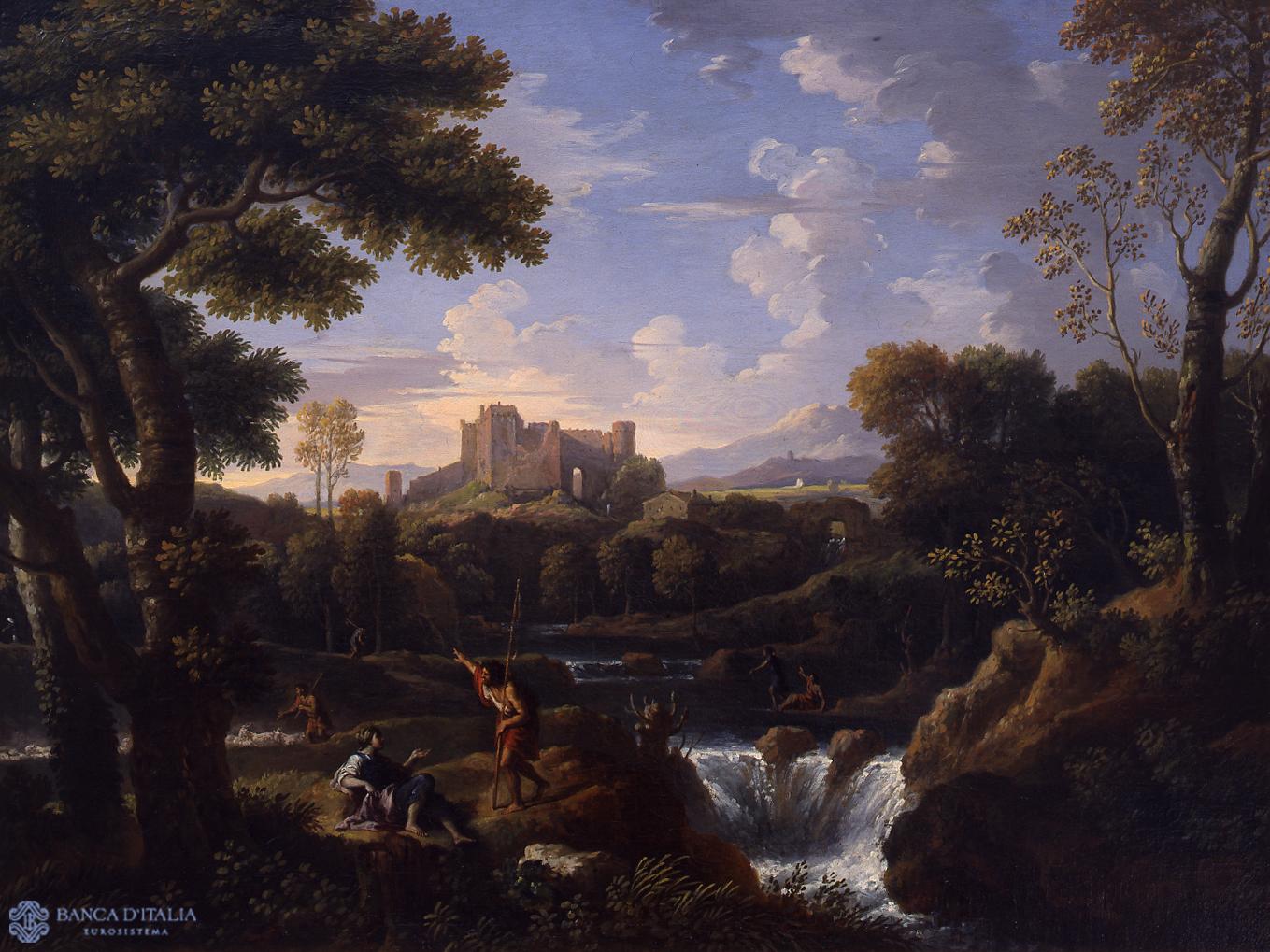
River Landscape with Castle Ruins
At the centre of this pleasant scene the artist has placed a stream, broken by the lively presence of a small waterfall. The banks are covered with a dense growth of Mediterranean vegetation, including oak and ilex.
Painting
18th century AD
Landscape
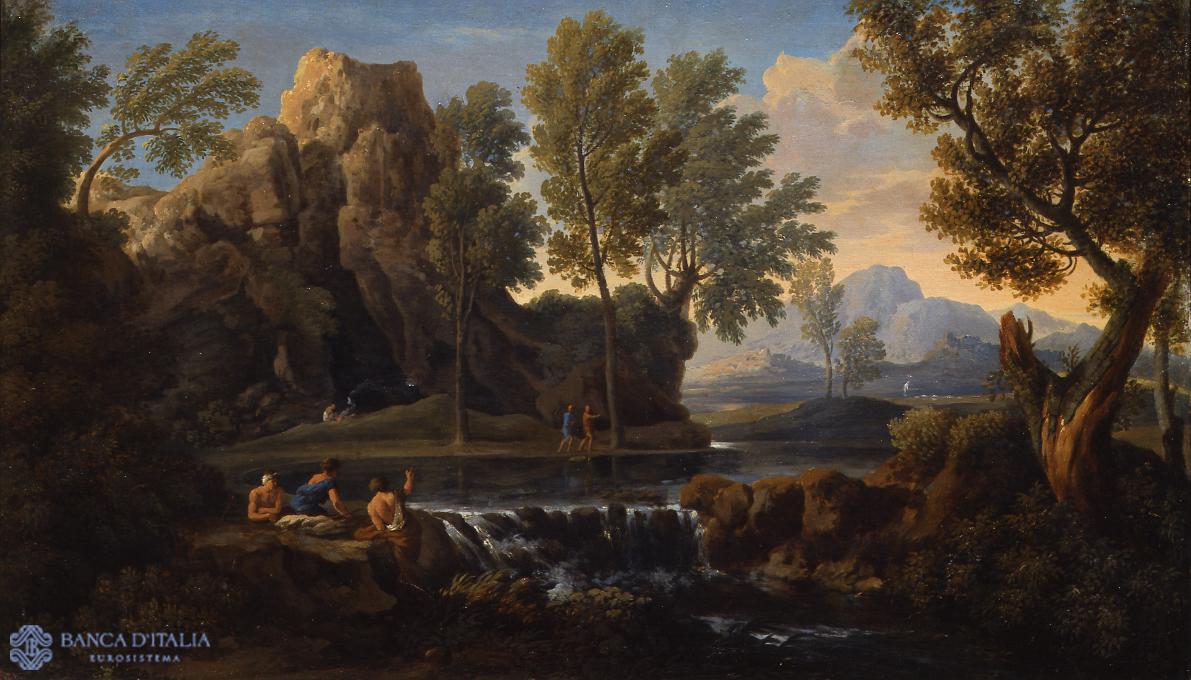
River Landscape with Figures
Van Bloemen depicts a pleasant valley in Latium through which a river slowly winds, its banks lined with rocky outcrops and windswept trees. In the background, two villages and a mountain range are visible, their grey-blue tint contrasting with the warm tones of the sky.
Painting
18th century AD
Landscape

River Landscape with Aqueduct and Figures
The wide landscape contains a river in the middle ground and behind it some ancient buildings, including a pyramid, an obelisk and the arches of an aqueduct. The right side of the canvas is dominated by a huge tree, perhaps an oak, beneath which a shepherd rests on a staff, talking to two peasant women.
Painting
18th century AD
Landscape
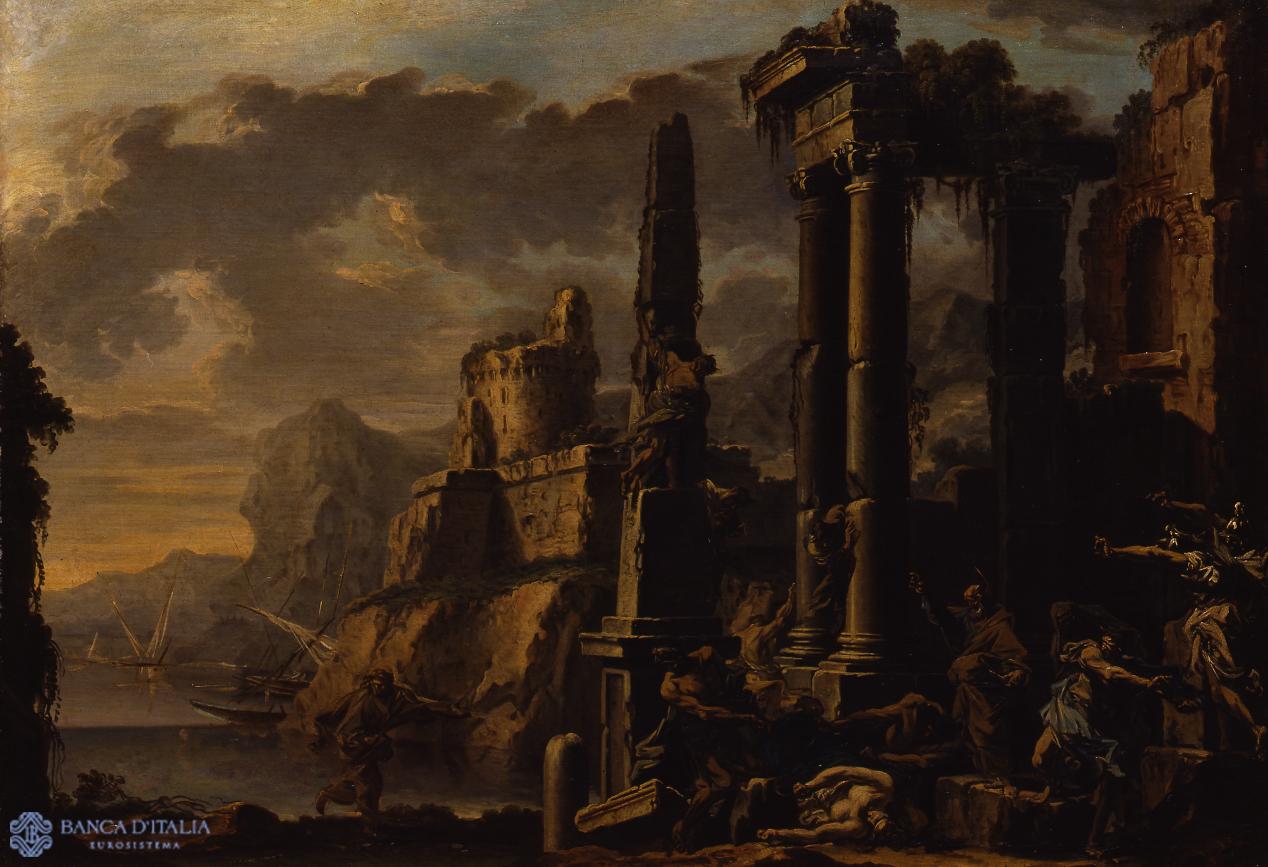
Seascape with the Death of Ananias and Sapphira
The subject of this dramatic painting, often interpreted as depicting the fall of Simon Magus, describes the episode from the Acts of the Apostles in which Ananias and his wife Sapphira are punished with death for defrauding the apostles.
Painting
18th century AD
Biblical - Historical - Mythologic

Latium Landscape
In this wide, light-filled landscape Andrea Locatelli depicts in the foreground a mixed group of figures gathered along a dirt track; they are shepherds driving their flocks home. On the left, a fisherman leaves the shore carrying a rod over his shoulder, while in the background the buildings of a town are visible.
Painting
18th century AD
Landscape
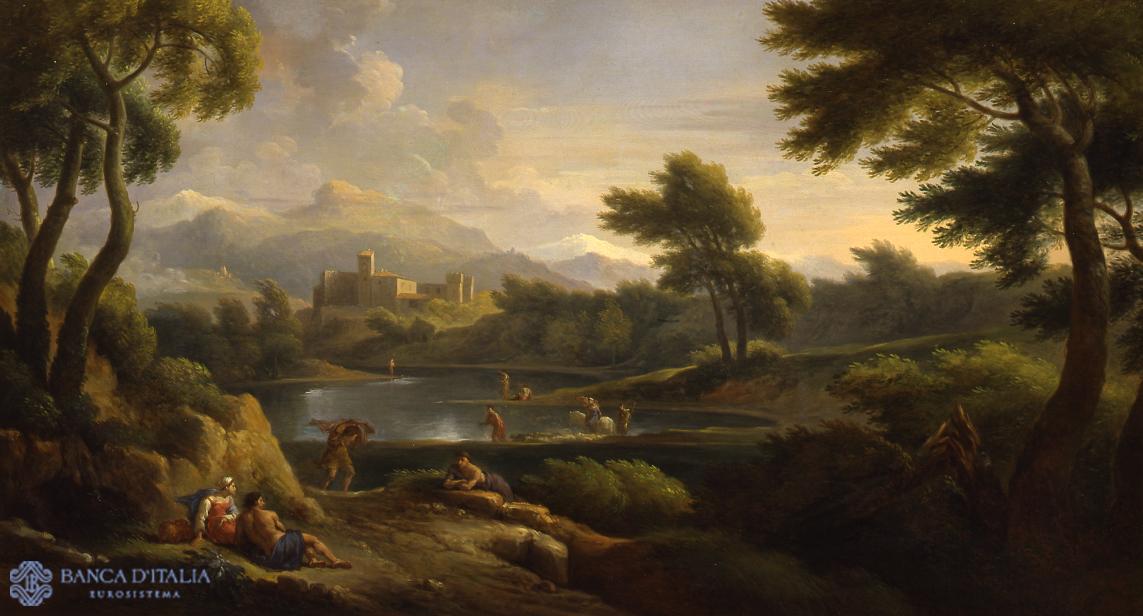
Landscape with River and Castle
Two groups of trees placed at the sides of the canvas frame a broad landscape that Jan Frans van Bloemen developed according to a well-established pattern: a rural scene set in the countryside around Rome, identified by ancient Roman buildings or, as in this case, by distant villages resembling those dotted around the city.
Painting
18th century AD
Landscape
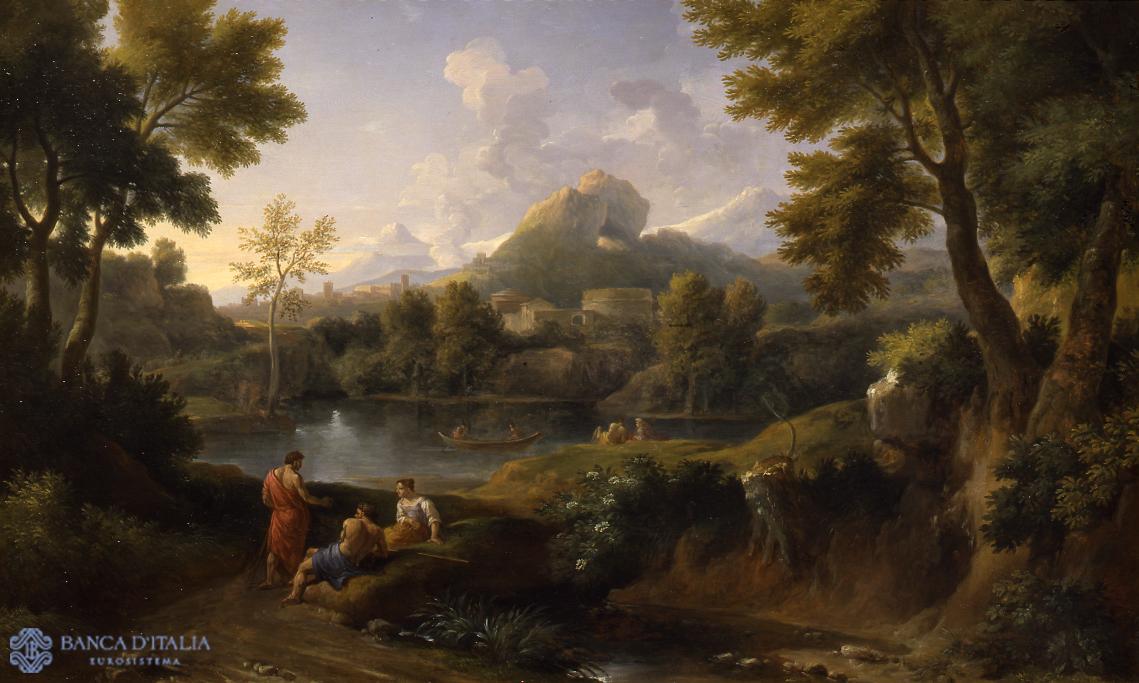
Landscape with Lake, Castle and Figures
The landscape is framed at the sides by two groups of trees, painted with great attention to detail, and in the distance by the outline of a mountain range. The raised viewpoint confers great breadth on the scene; it is a device for the experienced painter and its use earned van Bloemen the soubriquet ‘Orizzonte’ among colleagues from the Schildersbent, the guild of Dutch and Flemish artists active in Rome from the 1620s.
Painting
18th century AD
Landscape
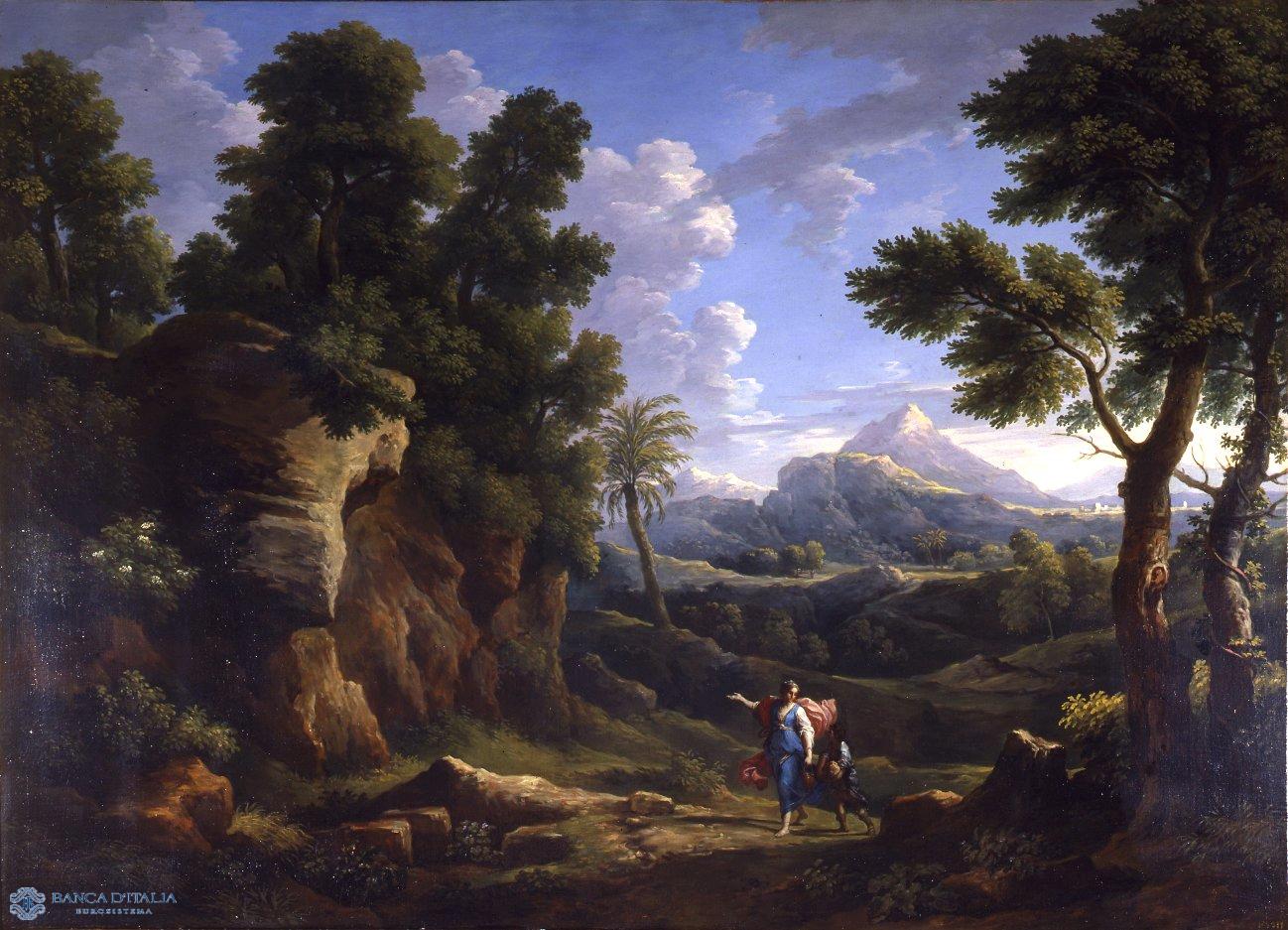
Landscape with Hagar and Ishmael
The subject of the painting is the story of Hagar and Ishmael told in Chapter 21 of the Book of Genesis. Abraham’s slave-woman and her son are given bread and a flagon of water and sent out into the desert of Beersheba. The two figures, in fact, carry a loaf of bread and a terracotta vessel.
Painting
18th century AD
Biblical - Historical - Mythologic
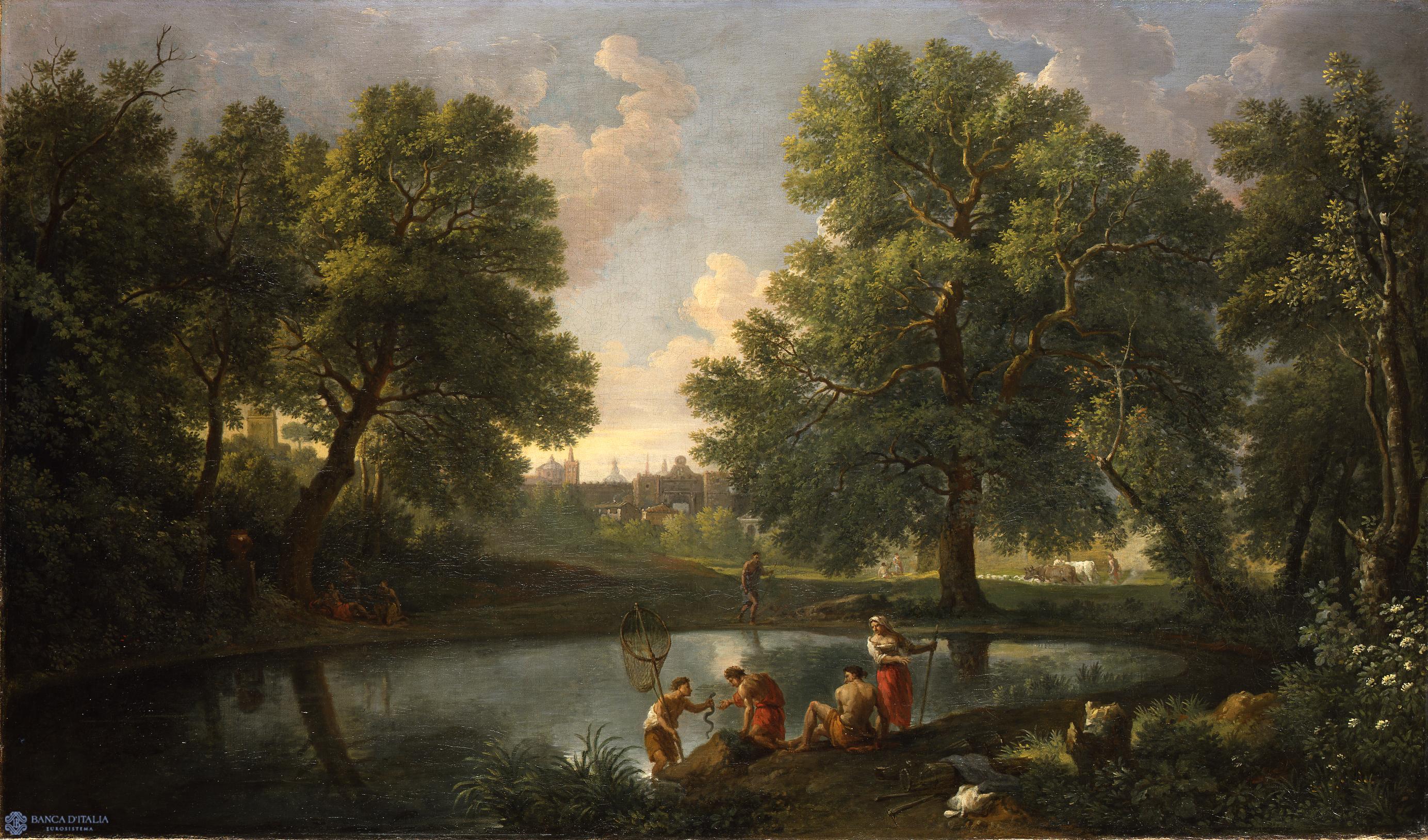
Landscape with Figures and Porta del Popolo
This is one of the few paintings in which van Bloemen depicts a real view of Rome and its environs. In most of his prolific output, the artist preferred to concentrate on idealized landscapes with a clearly classical stamp. Here, the scene unfolds on the shore of a small lake surrounded by trees.
Painting
18th century AD
Landscape
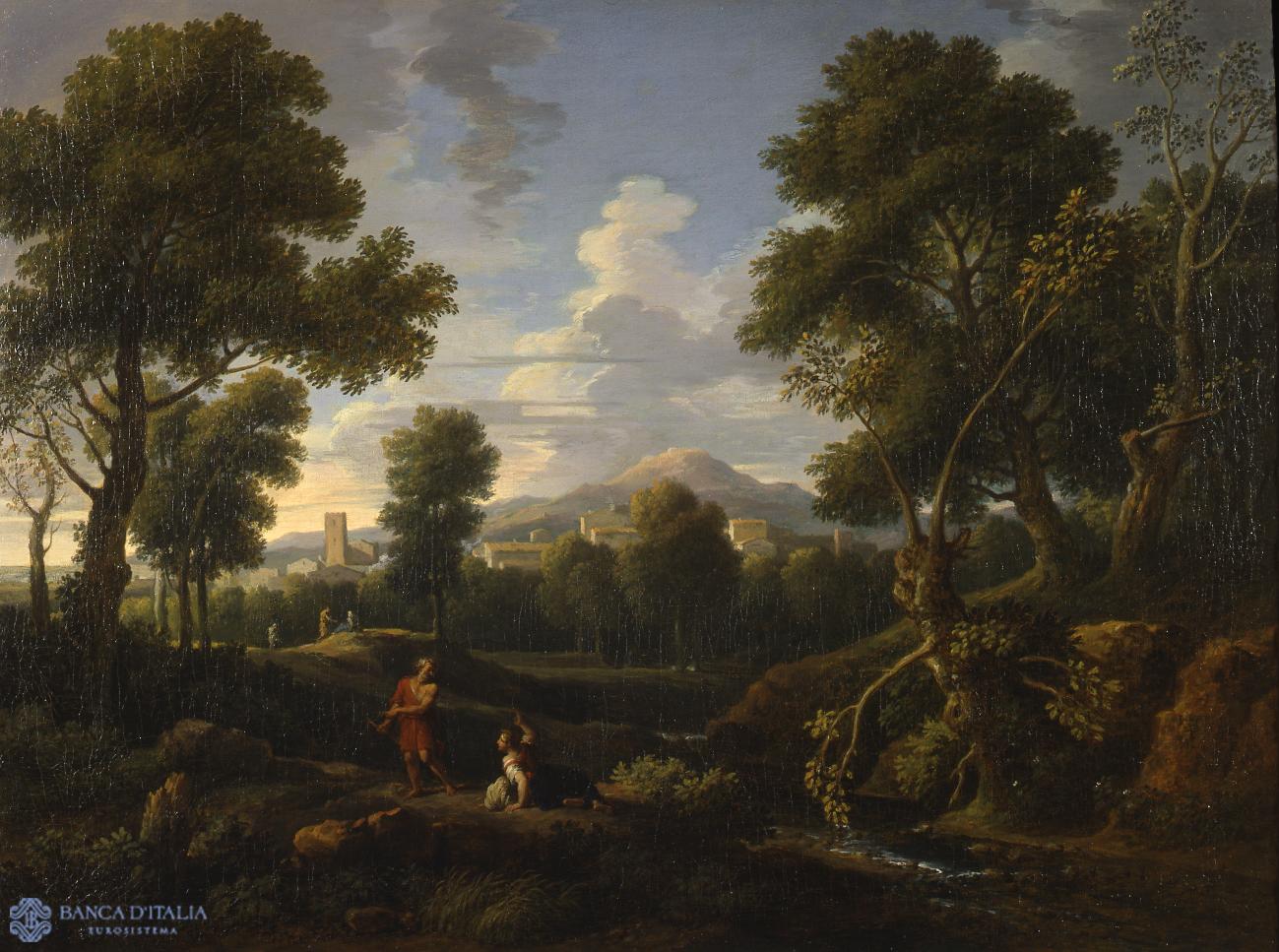
Landscape with Figures
Under a luminous sky, two characters are depicted in conversation by a stream. The elderly traveller, clothed in red, appears to be asking directions from a peasant woman sitting on the ground. Behind the trees in the middle ground the sun shines down on a small town.
Painting
18th century AD
Landscape

Landscape with a Fortified Town and Figures along a River
Van Bloemen, who was born in Antwerp, was a true specialist in the art of landscape painting. Here, he depicts a broad rural scene, at the centre of which an ancient fortified town perches on the edge of a rocky hillside. On the right, the roof of a church and huge bell tower emerge above a thick curtain of trees and bushes.
Painting
18th century AD
Landscape

The Infancy of Adonis
The painting illustrates the beginning of the myth of Adonis. His mother Myrrha, daughter of the King of Cyprus, had been transformed into the plant that bears her name, from the trunk of which a beautiful male child was born.
Painting
18th century AD
Biblical - Historical - Mythologic

Imaginary View of the Castelli Romani
The foreground of this bright landscape is filled with small, lively figures: a peasant-woman on a mule leads her herd of goats to pasture, a traveller and his dog set off across a bridge, and a family rests in the shade of a large tree.
Painting
18th century AD
Landscape

Giovane allevatore d’anatre
The painting captures a young peasant boy in poor clothing, a hat on his head, as he holds out an earthenware pot to a group of ducks swimming in a pond in the foreground. The scene takes place in the countryside, rendered by the fence behind the boy and the sheaf of corn on the left in the background.
Painting
18th century AD
Figurative

Coastal View with the Calling of Saint Peter
Magnasco sets this episode from the Gospel on the lakeshore, amid imposing ancient ruins. The jagged rocks and almost grotesque appearance of the figures add dramatic impact to the powerful scene. Jesus, his right arm forcefully raised, calls to the Galilean fisherman, who stops what he is doing to hurry towards Christ.
Painting
18th century AD
Biblical - Historical - Mythologic

Horses and Goats in a Stable
The painting is of the interior of an ancient building used as a stable, similar to the ones that the painter probably saw in Rome and the surrounding countryside. The view through the huge arch on the left is of a cloudy sky, a large tree and a piece of countryside stretching up to a line of hills.
Painting
17th century AD
Figurative
